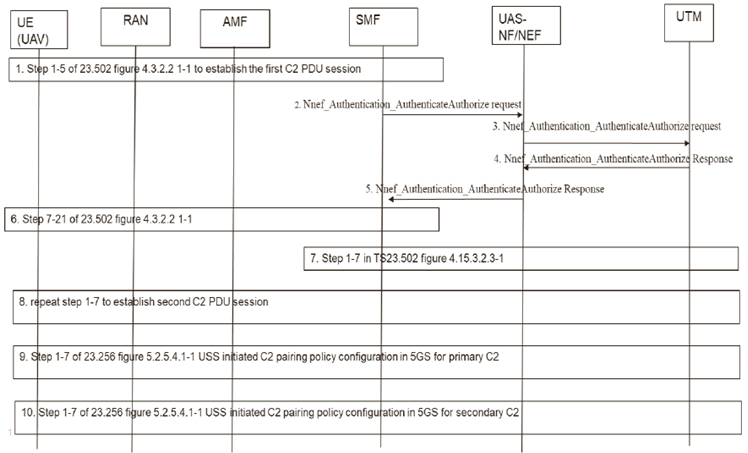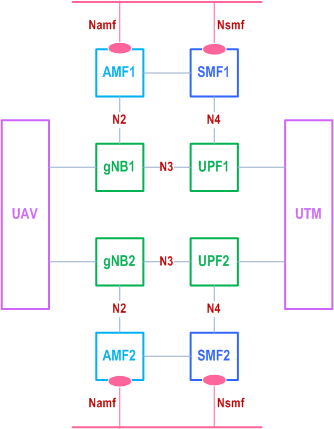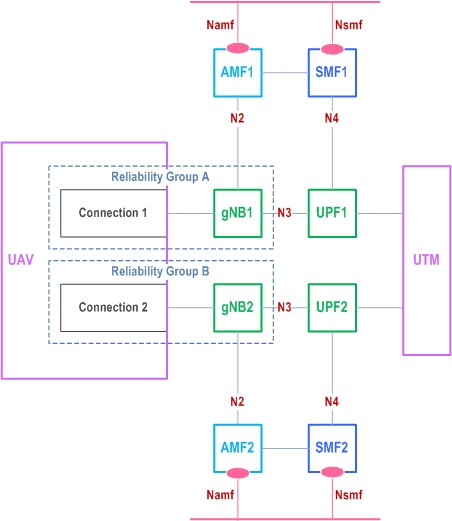Content for TS 23.256 Word version: 19.1.0
1…
4…
4.2…
4.2.3…
4.3…
4.4…
4.5…
5…
5.2.3…
5.2.4…
5.2.5…
5.2.5.3…
5.2.5.4…
5.2.7
5.2.8…
5.2.9…
5.3…
5.4…
5.5…
5.12…
5.13…
5.14…
6…
6.2…
6.3…
6.3.4…
A…
A Methods to support C2 communication reliability
A.1 Methods to establish redundant C2 connenctions for C2 communication reliability
A.2 C2 Communication Reliability with Redundant User Plane Paths
$ Change history
A Methods to support C2 communication reliability |R19| p. 106
A.1 Methods to establish redundant C2 connenctions for C2 communication reliability p. 106
Existing redundant transmission mechanism defined in TS 23.501 can be used for the End-to-End C2 communication reliability with additional redundant information in C2 aviation payload and C2 authorization payload to allow UAV or UTM to synchronize information regarding the usage of redundant C2 connections via 5G system, because existing paring information within the aviation payload only includes one C2 connection.
Following principles applies to establish redundant C2 connections for C2 communication reliability:
- UAV and 5G system support the redundant transmission mechanism defined in clause 5.33.2 of TS 23.501 to be able to establish two redundant C2 connection with a UAV-C or UTM within one network.
- The C2 redundant information is added into the C2 aviation payload (from UAV to UTM) and C2 authorization payload (from UTM to UAV) to exchange C2 redundant information between UAV and UTM. The redundant information can include the indication of establishment of redundant C2 connections. This C2 redundant information can be part of the C2 paring information associate with the UAV-C. It is up to UAV and UTM to decide which C2 PDU session is primary or secondary. 5G system is only aware of two C2 redundant connections being established and has no knowledge of the primary and secondary C2 connection.
- The information exchange using C2 aviation payload and C2 authorization payload between UAV and UTM on the status change of C2 redundant connection can occur during C2 PDU connection establishment / modification phase, or UAV controller replacement phase. In the Figure A.1-1, the UE initiation PDU session establishment for 2 redundant PDU sessions for C2 communications with a UAV-C is specified.

Step 0.
The UAV has performed a successful UUAA with the USS.
Step 1.
The UE first initiates PDU session establishment request for establishing the first PDU session for C2 connection with the UAV-C. In the PDU Session establishment request CAA-Level UAV ID, a C2 Aviation Payload to be used for C2 authorization which includes the C2 redundant information.
Step 2.
The SMF then sends a Nnef_Authentication_AuthenticateAuthorize request including the C2 Aviation Payload, which is used to request authorization redundant C2 communication with 2 redundant C2 connections.
Step 3.
The UAS NF/NEF forwards the received authorization request as a Naf_Authentication_AuthenticateAuthorize request to the UTM.
Step 4.
The UTM performs C2 authorization based on the received information and sends the Naf_Authentication_AuthenticateAuthorize response to the UAS NF/NEF including the Service Level Device Identity (e.g. the CAA-Level UAV-ID), the C2 Authorization Result and the C2 Authorization Payload (e.g. C2 redundant pairing information).
Step 5.
The UAS-NF/NEF forwards the information received from the UTM in the Nnef_Authentication_AuthenticateAuthorize response sent to the SMF.
Step 6.
SMF informs the UE about the C2 Authorization Result. SMF conducts PDU session establishment procedure until finalized for the establishment of the first C2 PDU session for the UAV-C.
Step 7.
[Conditional] If the C2 authorization is successful, the UTM subscribes via the UAS-NF to a PDU Session Status event for the PDU sessions used for the C2. The UAS NF determines DNN, S-NSSAI corresponding to the PDU session used for the C2 communication and uses this DNN, S-NSSAI to subscribe to SMF for PDU Session Status event. The SMF detects, as described in steps 6-7 of Figure 4.15.3.2.3-1 in TS 23.502, when the PDU Session is established and send the PDU Session Status event report to the UTM via UAS NF/NEF including GPSI and the C2 PDU session IP Address.
Step 8.
Repeat steps 1-7 to establish the second C2 PDU session.
Step 9.
(optional), The UTM stores the received two PDU session IP addresses and invokes the UTM initiated pairing policy configuration procedure (see Figure 5.2.5.4.1-1) for the primary C2 connection.
Step 10.
(optional), The UTM initiates C2 pairing policy configuration for the secondary C2 connection.
A.2 C2 Communication Reliability with Redundant User Plane Paths p. 107
Annex F in TS 23.501 specifies the mechanism that can be used to achieve redundant user plane paths. The similar mechanism can also be used to enhance the End-to-End C2 communication reliability in the scenarios where:
- a UAV has more than one SIM from a single operator and the UAV use them to set up redundant C2 connections to the UTM;
- a UAV is present in the area where RAN coverage allows the UAV to connect to multiple gNBs simultaneously. The selection of gNBs can be distinct from each other.
- separate gNBs nodes are required to achieve user plane redundancy over the 3GPP system. It is, however, up to operator's deployment and configuration to ensure that separate gNBs are available and used;
- a UAV is able to establish two (or multiple) independent connections to two (or multiple) independent gNBs;
- RAN coverage is so that the UAV is able to connect to multiple gNBs located in the target area. To ensure that the UAV connects to different gNBs, the gNBs need to operate in such a way that allows the UAV to select and connect to different gNBs (e.g. gNB frequency allocation supports such configurations/ scenarios);
- deployment of the CN and UPF in particular supports configuration/scenarios with redundant user plane paths;
- the underlying transport network's topology is aligned with the RAN and UPF deployments and supports configurations/scenarios with redundant user plane paths;
- the physical network topology and geographical distribution of network functions also supports configuration/scenarios with redundant user plane paths to the extent deemed necessary by the operator;
- operation aspects of the redundant user plane paths (for instance, independent power supplies) are made independent to the extent deemed necessary by the operator.

To ensure that the UAV selects different gNBs, UAV's connections and cells of the gNBs are grouped into more than one group (so-called Reliability Group) and the UAV selects the cells from the same reliability group as the connection. Figure A.2-2 shows an example, where Connection 1 and the cells of gNB1 belong to Reliability Group A and Connection 2 and the cells of gNB2 belong to Reliability Group B.

To determine Reliability Groups for the UAV, the methods shown in Figure F-2 in Annex F of TS 23.501 can be used. A Reliability Group of each of the connections is represented using the existing parameters and sent from the AMF to the RAN during the RAN context establishment; thus, each of the gNBs knows Reliability Groups of the UAV's connections. Reliability groups of gNB cells are pre-configured via the O&M and gNBs can either learn the Reliability Groups of the neighbouring cells as the Xn connectivity is set up or also configured by the O&M.
If the UAV leaves the cells of its currently connected Reliability Groups or if the quality of the connection drops below a certain threshold, the connections can be transferred to cells that belong to another Reliability Group. In such case, the gNB initiates the handover to cells in an appropriate Reliability Groups whenever such cells are available.